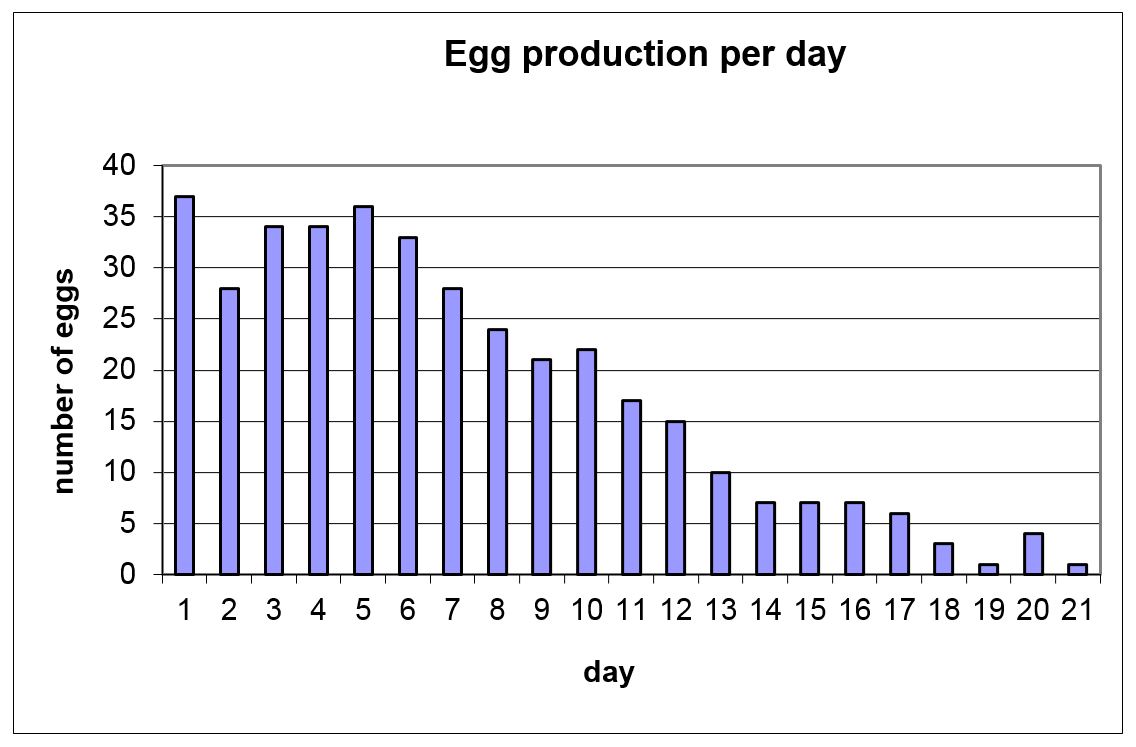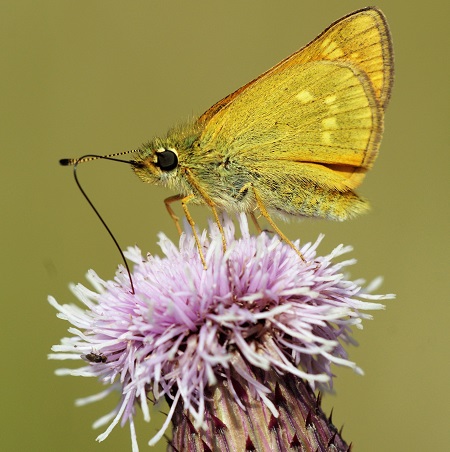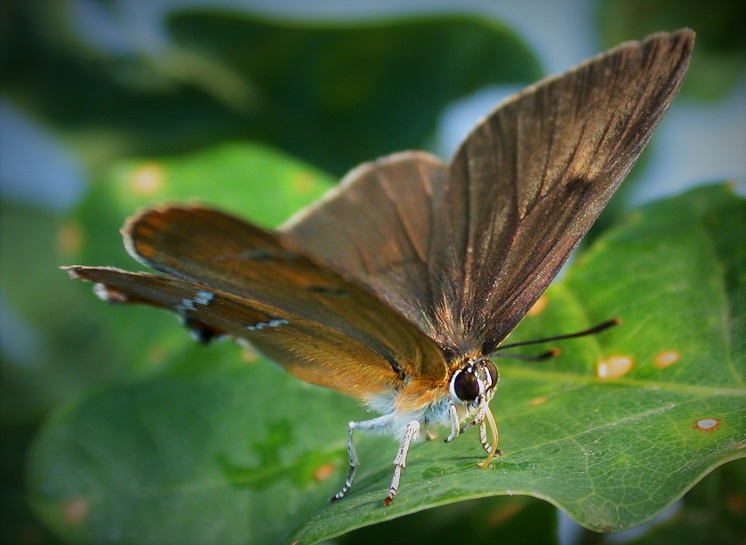|
4. Construction and function
A butterfly frolics about in the sunshine, in its youth it is a sluggish glutton that once fully grown and after a pupal stage, turns out to be an adventurer. For each of these phases it is constructed in such a way that it is well adapted for these different challenges of life.
About the insect
An insect is constructed after the successful design of head, thorax and abdomen. The head has the mouth and senses, the thorax the muscles and three pair of legs and two pair of wings, the abdomen contains the reproduction organs and stored food in fat filled cells. The construction of a butterfly is clearly formed after this principle, however in the case of a larva not much of this is visible. From the time the egg is laid until the hatching of the butterfly from its pupa, the whole process of metamorphosis has taken place.
A butterfly has, like every insect, an extern skeleton; thus it is necessary that this should be discarded and rebuilt several times during its development from larva, pupa to adult. Such procedure is marked by the shedding of the skin, a dangerous phase in this moulting process but also an opportunity to appear in a better adapted body for the next phase of development. In butterflies there are usually four larval moults, sometimes three or six. After hatching from the pupal case, it is time for reproduction. In some species this will be completed within one week, in others after a year.
Insects have a skin that is resistant to drought that makes even tiny insects able to live under very dry circumstances. The smaller the insect is, the more likely it is to dry out and die. This follows the law of the smaller the animal, the higher the dehydration risk because of the relatively greater surface of its skin to body weight. The insect skin is covered by a wax layer that is produced by the epidermis cells, a very effective construction to keep moisture inside; nevertheless among freshly hatched tiny larvae drying out is a serious mortality factor.
Respiratory system
Insects have a gas exchange system, which uses trachea branched into fine tubes. Each segment of the body has its own system with openings on each side, the stigmata, to give access to oxygen and discharge of carbon dioxide. The trachea of the various segments are interconnected making air circulation possible. Part of the tracheal system is wide and serves as air chambers; these are situated in the front part of the abdomen. If the thoracic muscles have a high oxygen demand, fresh air can be delivered via these air sacs. Air circulation in the tracheal system is brought about passively by the activity of muscles inside the body.
Trachea form also the veins of the wings, at hatching they are filled with blood under pressure which unfolds the soft wings. Later on the blood is retracted and the hollow veins function as a support which stiffens the wings.
This tracheal system has one danger, during skin shedding the trachea have also to be renewed; this happens because the trachea are fixed to the stigmata and when skin is shed the interior part will be pulled out. Should this fail, the remains of the old trachea will obstruct the air-movement and hence gas exchange.
The butterfly
The butterfly is an adventurer which survives solely on liquids and finally will find a mate. A unique structure in Lepidoptera is the feeding device, the proboscis. This is derived from two appendages of the jaws which form a tube that coils like a spring. It can only be used for sucking up liquids and the length of this proboscis determines the depth at which the nectar of flowers is accessible. The length of a proboscis can be measured from its sheath visible on the outside of the pupa.
|
|
Photograph (left): Ochlodes sylvanus. Jeroen Voogd ©.
The large skipper (Ochlodes sylvanus) has a very long proboscis and is able to get the nectar of all different shapes of flowers.
The brown hairstreak (Thecla betulae) is very limited in reaching food sources because of its very short proboscis.
Photograph (right):
Thecla betulae. Frits Bink ©. |
The wings of a butterfly are driven indirectly by two pairs of muscles inside the thorax. Two vertical ones that make the thorax flatten and two longitudinal ones which make the thorax become rounder. The thorax is a box with a stiff upper and underside connected to flexible sidewalls. The thorax can transform alternately rounder and flatter and a complicated mechanism turns this into the flutter movement of the wings. This remarkable construction of this box with stiff and elastic parts saves energy.
Butterflies have a large wing area compared to their body weight. This means that they cannot fly fast; however they are specialised in flying with low energy usage. Big butterflies can soar at low speed and save energy, small butterflies are not adapted to do this. For example Skippers have a small wing area in relation to their body weight and they fly fast with high frequency wing beats.
Most butterflies fly at a speed comparable with the speed of a cyclist, about 15km/hour (4m/sec). Skippers and migrants can fly faster, about 20km/hour (5.5m/sec) and some can sprint at high speed like the painted lady, up to 40km/hour (11m/sec). On the other hand there are some which can fly very slowly and soar at about 3km/hour (˂1m/sec) in gliding flight.
Butterflies that are migrating fly in a straight line. They fly low to the ground where the wind is slowed down by the vegetation when they experience head-wind and they climb high in the sky nearly out of our sight when they have tail wind.
The easiest way to present the size of butterflies is by the length of their forewing from base to tip in millimetres. Twice this wing measurement is about the wing span. The wing spans of butterflies occurring in the Benelux vary from 20 to 100 mm. An example of the former is the small blue (Cupido minimus) and of the latter is the swallow tail (Papilio machaon).
Reproduction
The reproductive device in the abdomen of a butterfly consists of eight ovarioles running from the germarium (cluster of reproduction cells) to the oviduct, from where an egg will leave the body after being fertilized when the egg passes the sperm receptacle, the receptaculum seminis, where the sperm is stored after copulation. A spermatozoid then has the opportunity to enter the egg through the micropyle on the top of the egg, then the ovum and the sperm will fuse inside the egg shell.
An ovariole consists of a row of very small eggs, hardly visible to the naked eye. A fully developed egg is then fully chorionated and the egg shell has its final structure. An ovariole can be seen as a production line of the egg factory. Eggs as small as a 0.05 part of a fully developed egg can be seen by eyes, to see the smaller ones the use of a microscope is necessary.
Inside an ovariole between one and ten eggs per day may develope, depending on the species. So the female butterfly with eight ovarioles can produce about 8 to 80 eggs per day. Butterflies of the tribe Theclinae produces less than eight eggs per day, some of the Pierinae, in particular the large white (Pieris brassicae) more than 80. The total number of eggs produced depends on the longevity of the butterfly.
With regard to the reproduction ability of a butterfly three parameters are involved:
1. The size of the egg in relation to the body size, in the abdomen there is usually room for 100-150 eggs at the same time.
2. The speed with which new eggs develop during the oviposition period.
3. The total number of eggs females can produce.
Some interesting exceptions occur with regard to the first parameter. In the family of the whites (Pieridae) there is a great variety in body size, the smallest is the wood white (Leptidea sinapis) and one of biggest is the large white. Their eggs are all about the same size, the body of the wood white is already full with about 30 (19-41) eggs in the abdomen, that of the large white with about 83 (54-112) eggs. The species that may have the largest number of eggs in the body is the marsh fritillary (Euphydryas aurinia) of which some individuals may have up to 600 eggs and in this case the butterfly is so heavily loaded that it can hardly fly.
The second parameter is linked with the longevity of the female butterfly. Species with females that hatch, from the pupal case, with an abdomen fully loaded with mature eggs need little time to oviposit. They are short lived, usual shorter than one week. On the other hand species with long lives may have a continuing egg production and the total number of eggs produced may be up to ten times the amount laid on the first day. The results of a breeding experiment by Christer Wiklund at Stockholm (letter 5 May 1986) shows clearly how the process evolved in the swallowtail (Papilio machaon): 14 females lived for about 18 (14-22) days and produced on average 357 (265-449) eggs per female. At the start of oviposition 28-37 eggs per day were laid. However, this number declined gradually, as the ability in producing eggs in the ovarioles decreased. During the first ten days in the life of a swallowtail 80% of the potential production is already laid.
Figure 4-1. Egg production of the swallowtail (data Christer Wiklund 1986)

Oviposition can be interrupted in the case of a poor weather when egg development will stop because the ovarioles become full. However, during migration the ‘egg factory’ will not only be closed but even dismantled and all fat reserves consumed. A butterfly after a long migration has a fully shrunk abdomen and it has to find a good place to recover. Egg production continues then in waves: egg laying – migration – recovering – egg laying – and so on. The painted lady (Vanessa cardui) is an example of such reproductive behaviour.
The egg
Butterfly eggs may be relatively small in comparison to the body and in that case the butterfly usually produces a large number, alternatively the eggs may be relatively big and a small number is laid per day, as in the hairstreaks (Theclinae).
The egg shell may be very weak and for that reason it is laid in a flower head, or alternatively the egg is relatively big with a tough shell. That happens in species which hibernate as egg on a twig of a tree or shrub. This is also typical of Theclinae.
The egg shell will be eaten, at least for a small part, by the hatching larva to leave the egg but there are also species in which the young larvae consume the whole shell as food.
Eggs may be laid in a mass on a twig or leaf of the host-plant or single and widely dispersed. In the first case the newly hatched larvae will cooperate and spin a protective web. This is typical in the Melitaeini and in some Nymphalinae. Eggs which are widely dispersed are most common. This may be seen as a strategy to avoid parasitation and it is also an adaption to be able to live in a changing landscape.
The larva
A caterpillar is a glutton shaped as a sausage, its stiffness comes from the tension by muscle contraction; a dead larva is flabby. A larva needs a good grip on slippery surfaces. Besides its six thoracic legs it has eight pro-legs and a pair of claspers which are fitted with fine hooks, on the last segment. If the larva has insufficient grip on the surface, it spins a silk thread upon which to climb further.
The larva selects the right food that can be digested by its intestines. The food should be enough nutritious and not poisonous and must have the right taste. In many cases the poison of a particular plant species is just the trigger to eat such as the poison glucosinolate of crucifers (Brassicaceae) for many species of whites (Pieris sp).
The larva is also a pray for insectivorous animals like birds. Many species have larvae which can defend themselves chemically by having poison in the body or a repulsive taste or by a mechanical means such as stings or irritating hairs. In most cases however, a larva defends itself by camouflage, mimetic forms or misleading behaviour.
Defence against parasites is very difficult and it is the egg-laying female that can make it as difficult as possible for the parasites by distributing her eggs over a large area.
The pupa
There are many species of butterfly which have a hard pupa, which can endure frost, heat, dryness or moistness and is attached in the open air to a wall, tree trunk or stem by a silken girdle around its thorax and by hooks on the cremaster (the claspers) at the tip of the abdominal to a silken pad constructed by the larva. This is typical in the Pieridae.
Some species have larvae that pupate in the ground, a good way to survive summer heat. This is typical in Satyrinae.
Many species pupate in the litter or moss-layer and have no particular protection. This is typical for the Polyommatinae, although a lot of these species have larvae that can secrete a fluid which is attractive to ants or the pupa can stridulate, tending to reduce predation.
A remarkable way of pupating is the hanging pupa; the pupa is attached only by its cremaster to the silken pad, hanging upside down. A few species have pupae decorated by golden or silvery spots. This is typical in Nymphalinae and Heliconiinae.
|



